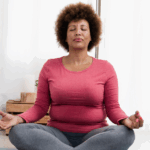Every breath you take fuels your body with oxygen, the element your cells need to create energy, repair tissues, and keep your brain sharp. Yet we rarely pause to think about how essential healthy lungs are until illness, pollution, or stress makes breathing feel difficult.1
Taking care of your lungs isn’t just about preventing disease, it’s about improving the quality of every moment you live. And one of the most powerful, accessible tools is already within you: breathing exercises.
How the Lungs Work
Your lungs are intricate organs, shaped like two spongy wings on either side of your heart. Each time you inhale, air travels through branching airways until it reaches tiny sacs called alveoli.1
Here, oxygen moves into your bloodstream while carbon dioxide, the waste product of metabolism, is carried out. The diaphragm, a dome-shaped muscle beneath the lungs, contracts and relaxes with every cycle, orchestrating this dance of life.1
When lung function is impaired, whether from asthma, lung cancer, chronic obstructive pulmonary disease (COPD), or environmental triggers, the entire body feels it: fatigue creeps in, brain fog lingers, and even the heart works harder.1
Why This Matters for Our Communities
For many underserved communities, lung health is under constant threat. Asthma disproportionately affects Black and Latino children, often worsened by exposure to polluted air near highways or industrial sites.2
Rates of COPD are higher in rural and low-income populations, where access to preventive care and smoking cessation programs is limited.3 Many work in jobs with higher exposure to dust, smoke, or chemicals, further straining their lungs. And systemic inequities, such as fewer clinics, limited insurance coverage, or medical bias, mean people often don’t get help until symptoms become severe.3
Breathing exercises can’t replace medical treatment, but they are free, low-risk, and empowering tools that anyone can use to support their lungs.
Exercises You Can Incorporate Into Your Daily Routine
1. Diaphragmatic (Belly) Breathing
This foundational exercise strengthens the diaphragm, making each breath more efficient. It helps train your body to use deeper, fuller breaths rather than shallow chest breathing.4
Let’s try it together: Lie on your back or sit comfortably. Place one hand on your chest and the other on your belly. Inhale slowly through your nose—feel your belly rise while your chest stays still. Exhale gently through pursed lips. Repeat for 5–10 breaths, noticing the calm that follows.
2. Pursed-Lip Breathing
Especially helpful for people with COPD or asthma, this technique eases shortness of breath by slowing exhalation and keeping airways open.4
Let’s try it together: Inhale slowly through your nose for two counts. Purse your lips as if you’re about to whistle, then exhale gently for four counts. Feel the tension leave your body as you release the breath. Try this for 1–2 minutes.
3. Box Breathing (4-4-4-4 Method)
Used by athletes and even Navy SEALs, box breathing improves lung control and calms the nervous system.4
Let’s try it together: Inhale through your nose for four counts. Hold your breath for four counts. Exhale slowly for four counts. Hold again for four counts before repeating. Imagine drawing the sides of a box in your mind as you move through each step. Practice for 4–5 rounds.
4. Alternate Nostril Breathing
Rooted in yogic traditions, this practice balances airflow and reduces stress.4
Let’s try it together: Sit upright. With your thumb, close your right nostril and inhale slowly through your left. Close the left nostril with a finger, then exhale through your right. Inhale again through the right, close it, and exhale through the left. This is one full round. Practice 5–10 rounds, moving slowly and steadily.
5. Segmented (Stair-Step) Breathing
This exercise teaches lung expansion in small increments, strengthening control.4
Let’s try it together: Take three short, sharp inhales through your nose, stacking air in your lungs. Then release it all in one long, steady exhale through your mouth. Repeat 5–7 times, noticing how your lungs gradually feel stronger and more open.
Building Your Breathing Routine
Set aside 5–10 minutes each day to practice. Start with diaphragmatic and pursed-lip breathing, then layer in box or alternate nostril breathing for balance and stress relief. If you feel dizzy or your symptoms worsen, stop and speak with a healthcare provider. Breathing exercises should complement, not replace, professional medical care.
Always Come Back to Your Breath
Breath is more than physiology; it is life, resilience, and restoration. For communities historically burdened by health inequities, breathing intentionally can be both a health practice and an act of liberation.
Stronger lungs mean more energy for daily life, better sleep, sharper focus, and a body better prepared to resist illness. By practicing these exercises and advocating for cleaner air and equitable healthcare, we honor the power of our lungs, and reclaim the fullness of every breath.
References
- ALA. (2025, July 24). How Lungs Work. Retrieved from American Lung Association: https://www.lung.org/lung-health-diseases/how-lungs-work
- AAFA. (2020). Asthma Disparities in America. Retrieved from Asthma and Allergy Foundation of America: https://aafa.org/asthma-allergy-research/our-research/asthma-disparities-burden-on-minorities/
- Raju, S., Keet, C. A., Paulin, L. M., Matsui, E. C., Peng, R. D., Hansel, N. N., & McCormack, M. C. (2019). Rural Residence and Poverty Are Independent Risk Factors for Chronic Obstructive Pulmonary Disease in the United States. American Journal of Respiratory and Critical Care Medicine. doi:10.1164/rccm.201807-1374OC
- ALA. (2025, July 25). Breathing Exercises. Retrieved from American Lung Association: https://www.lung.org/lung-health-diseases/wellness/breathing-exercises









